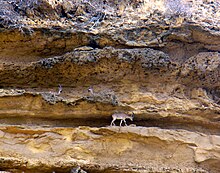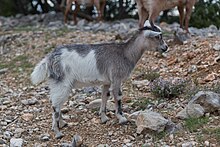Wild goat
| Wild goat | ||||||||||||
|---|---|---|---|---|---|---|---|---|---|---|---|---|

Bezoar goat ( C. a. Aegagrus ) |
||||||||||||
| Systematics | ||||||||||||
|
||||||||||||
| Scientific name | ||||||||||||
| Capra aegagrus | ||||||||||||
| Erxleben , 1777 |
The wild goat ( Capra aegagrus ) is a mammal of the family Bovidae (Bovidae) and the ancestor of the domestic goat . It is distributed in several subspecies in western Asia, the best known of which is the Bezoar goat ( Capra aegagrus aegagrus ).
features
Wild goats reach a head body length of 1.2 to 1.6 meters, in addition there is a 15 to 20 centimeter long tail. The shoulder height is 0.7 to 1 meter and the weight 25 to 95 kilograms. Their physique is stocky, their limbs are strong and their hooves are broad.
Males of the wild goat have a silver-white fur in winter, the underside and parts of the face are black-brown. There is a black stripe along the back and a black stripe in the shoulder area from the back to the chest. Towards summer the fur becomes shorter and the basic color reddish brown. Females are colored yellowish-brown all year round, but also have a dark stripe on the back.
Both sexes have horns, but the males are significantly larger. Those of the females are slightly curved, 20 to 30 centimeters long and relatively thin. The horns of the males are curved backwards in the shape of a saber and can be up to 1.3 meters long.
distribution and habitat
The original range of the wild goat covered parts of western Asia. It stretched from Anatolia through the Caucasus region to Afghanistan and Pakistan . Stocks in Oman and on some Greek islands are likely to be traced back to wild animals. They can be found in a number of habitats, including mountainous regions up to 4200 meters above sea level, but also desert regions and forest areas.
Way of life
Wild goats are primarily active at twilight and foraging for food in the early morning and late afternoon. However, in the hot season, they rest during the day and become active at night. They live in herds that comprise an average of 5 to 25 animals, depending on their habitat and region. Females and their offspring live in groups of females all year round and only withdraw from the group briefly at birth. Males spend most of the year in bachelorette groups of around 4 to 5 animals. They establish a ranking within these groups. During the rutting season they join the herds of females and sometimes fiercely fight with other males for mating privilege.
Wild goats are pure herbivores that ingest grass, herbs and other plant material.
The mating takes place between August and December, depending on the region, after a 150 to 170-day gestation period, the female gives birth to one or two young between January and May. These are fleeing nests , they weigh around 2 kilograms at birth and can walk within 24 hours. They are weaned after around four to five months, but remain with the mother until the next mating or birth period. Females give birth to offspring for the first time when they are around three years old.
Systematics and naming

The domestic goat (as Capra hircus ) and the wild goat (as Capra aegagrus ) were originally described as two different species. Today they are grouped into one species, according to the decision of the ICZN (Opinion 2027) aegagrus is the valid name.

Wilson and Reeder (2005) distinguish the following six subspecies (but with the specific epithet hircus ):
- The domestic goat ( Capra aegagrus hircus ) is the domesticated form of the wild goat that is widespread worldwide today.
- The bezoar goat ( C. a. Aegagrus ) is widespread from Turkey to Afghanistan .
- The Chiltan goat ( C. a. Chialtanensis ) lives in Pakistan . It is severely threatened, there are only 500 copies left. This subspecies is likely to be a hybrid form between wild goat and screw goat.
- The Cretan wild goat ( C. a. Cretica ) lives on Crete and neighboring islands.
- Capra aegagrus jourensis occurs on the Sporades island Gioura .
- Capra aegagrus picta isnativeto the Cycladic island of Andimilos .
The status of the last three subspecies only found on Greek islands is controversial. According to recent findings and genetic studies, however, these populations are more likely to be domestic goats that were feral a long time ago. Two other subspecies, the Sindh wild goat ( C. a. Blythi ) and the Turkmen wild goat ( C. a. Turcmenica ), are controversial.
Wild goats and people
Wild goats were domesticated very early on . What is certain is that it was around 6000 BC. Were already domestic goats. According to recent archaeological finds in Iran, it is even possible that domestication dates back to around 8000 BC. Was already completed. From there, domestic goats were spread across the globe - since there have never been wild goats on the European mainland, all European goats descend from Asian ancestors.
The wild goat itself is threatened. The reasons for this are hunting and displacement from their habitat by domestic animals, including domestic goats. The IUCN lists the wild goat as endangered ( vulnerable ).
literature
- Ronald M. Nowak: Walker's Mammals of the World . Johns Hopkins University Press, 1999, ISBN 0-8018-5789-9
- DE Wilson, DM Reeder: Mammal Species of the World . Johns Hopkins University Press, Baltimore 2005, ISBN 0-8018-8221-4
Web links
- Capra aegagrus in the endangered Red List species the IUCN 2006. Posted by: Caprinae Specialist Group, 1996. Retrieved on 11 May, 2006.
Individual evidence
- ^ Opinions March 2003 ( Memento from April 22, 2008 in the Internet Archive )
- ↑ Armelle Frédérique Gardeisen & al .: Genetic evidence for the origin of the agrimi goat (Capra aegagrus cretica) . In: Journal of Zoology 2002, No. 256, pp. 369-377

